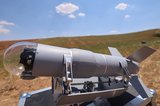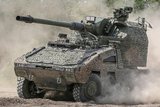US Army issues JETS TLDS prototype contracts
The US Army has selected DRS and BAE Systems for the three-year engineering and manufacturing development (EMD) phase of the Joint Effects Targeting System (JETS) programme. The companies will develop Target Location Designation System (TLDS) prototypes under the contracts, worth $15 million each.
Systems delivered as part of the JETS programme will provide the dismounted forward observer and Joint Terminal Attack Controllers the ability to acquire, locate and mark for precision Global Positioning System-guided and laser-guided munitions. The TLDS component of this system will provide the dismounted forward observer with a common and light-weight handheld precision targeting capability.
The JETS programme is led by the US Army but is a joint interest programme with the US Air Force and Marine Corps.
BAE Systems is offering its new Handheld Azimuth Measuring, Marking, Electro-optic imaging & Ranging (HAMMER) precision targeting system under its $15 million contract. HAMMER allows dismounted combat operators to locate and mark targets in all weather and lighting conditions, and was developed to support the missions of today’s warfighter while significantly reducing collateral damage and friendly fire incidents.
HAMMER builds on the company’s already-fielded Target Reconnaissance Infrared Geolocating Rangefinder (TRIGR) system, and adds enhanced precision targeting capabilities with the addition of a compact laser marker and a non-magnetic compass.
DRS has been awarded $15.5 million for its prototype development. The company said it will offer an integrated design that affordably improves soldier precision targeting capability, but did not offer any further information on its offering.
More from Land Warfare
-
![Dedicated drone munitions could unlock modular mission potential]()
Dedicated drone munitions could unlock modular mission potential
Top attacks have proven effective against heavily armoured vehicles in Ukraine. A new family of uncrewed aerial system-delivered munitions is looking to press that advantage further.
-
![Elbit bets on local content for US howitzer bid as it faces off against popular systems]()
Elbit bets on local content for US howitzer bid as it faces off against popular systems
The Israeli company hopes that producing its Sigma artillery system wholly in the US will help it win a key US Army contract, but it will be up against the popular CAESAR Mk II wheeled weapon and the K9 tracked.
-
![Germany orders 84 Boxer howitzers as UK commits to a single demonstrator]()
Germany orders 84 Boxer howitzers as UK commits to a single demonstrator
Germany has ordered 84 RCH 155 self-propelled guns, as system incorporating Boxer 8×8 vehicles and the Artillery Gun Module, and 200 Puma Infantry Fighting Vehicles while the UK has committed to a single Early Capability Demonstrator RCH 155.
-
![Companies look to tank-launched guided projectiles for non-line-of-sight effects]()
Companies look to tank-launched guided projectiles for non-line-of-sight effects
While integration of guided weapons on modern armoured vehicles usually takes the form of a podded launcher on the turret exterior, recent developments suggest the concept of firing missiles from a tank’s main gun could be seeing a revival.
-
![Germany signs multi-billion-dollar deals for 6x6 CAVS and GDELS Eagle vehicles]()
Germany signs multi-billion-dollar deals for 6x6 CAVS and GDELS Eagle vehicles
The order is a further boost for the Common Armoured Vehicles System programme which has notched notable successes in the past 12 months. The first vehicle, made in Finland, will be delivered next year with local production expected to ramp up in 2027.























